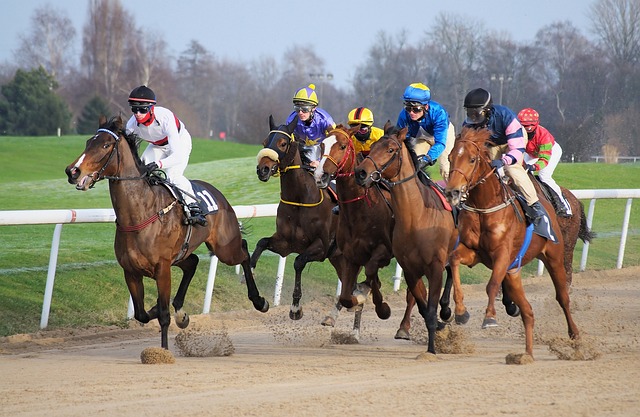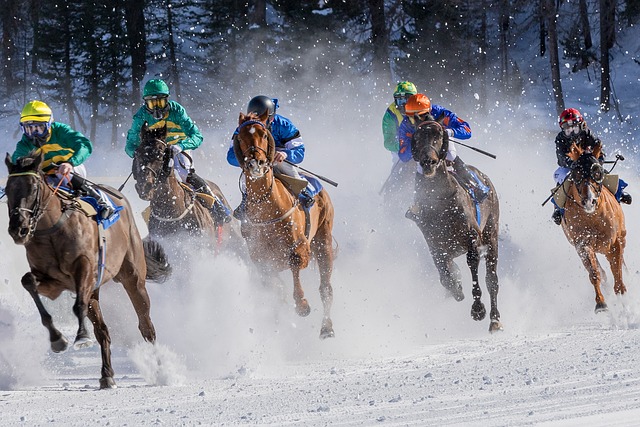When you watch a horse race, it’s not just about the excitement and speed—it’s a puzzle of various pieces coming together. Have you ever wondered why some races are over in a flash while others seem to stretch on?
Well, The solution is found in the intriguing concoction of variables that affect race duration.
However, The duration of a horse race can vary widely based on factors like the type of race, distance, track conditions, weather, horse ability, and more. On average, a typical horse race can last anywhere from about 1.5 to 4 minutes.
In addition, it’s important to note that this is a general range, and actual race times can fall outside of this estimate. For example, shorter sprint races might be completed in around 1 to 2 minutes, while longer steeplechase races with obstacles could take closer to 3 to 6 minutes or more.
So, whether it’s a swift sprint or a marathon gallop, each race is like a unique story, told in the time it takes those hooves to cross the finish line. Here You will get learn about this mystery.
Exploring Horse Race Durations: How Long Do They Last?
Race Distance and Type:
The length of the race track is a major factor in determining race duration. Shorter distances result in quicker races, while longer tracks naturally take more time to complete. Different race types, such as sprints, mile races, and longer routes, contribute to varied pacing and duration, offering diverse spectator experiences.
| Race Type | Distance Range | Description | Approximate Duration |
|---|---|---|---|
| Sprint Races | 5 to 7 furlongs | Short, intense, emphasizing speed | 1 to 2 minutes |
| Mile Races | Around 1 mile | Balancing speed and endurance | 1.5 to 2.5 minutes |
| Route Races | More than 1 mile | Emphasizing endurance, conserving energy | 2.5 to 4 minutes |
| Steeplechase Races | 2 to 4 miles | Obstacle-filled, adding challenge and strategy | 3 to 6 minutes or more |
| Handicap Races | Various distances | Weight-based competition, exciting and unpredictable | Duration varies |
| Derby Races | 1.25 to 1.5 miles | Prestigious classics with longer distances | 2.5 to 3.5 minutes |
| Oaks Races | 1.25 to 1.5 miles | Female-only events showcasing talented fillies | 2.5 to 3.5 minutes |
Track Conditions: The condition of the track significantly impacts race tempo. Dry, firm paths facilitate swift movement, while wet or muddy terrain slows. down the horses. Track conditions add an element of unpredictability to race durations.
Horse Speed and Ability:

The fitness, training, and racing abilities of the horses influence their navigation of the course. Faster and well-conditioned horses tend to complete races more quickly, affecting overall race times.
Thoroughbreds (Sprint and Mile Races): Thoroughbreds are renowned for their speed and agility. They excel in sprint races, covering short distances of about 5 to 7 furlongs in 1 to 2 minutes. Their ability to accelerate quickly and maintain high speeds suits these intense races. Thoroughbreds also perform well in mile races, striking a balance between speed and endurance.
Endurance Breeds (Route Races): Breeds like Arabians, known for their endurance, thrive in route races. These horses can cover longer distances of over 1 mile in around 2.5 to 4 minutes. Their ability to sustain a steady pace and conserve energy is crucial for success in these races.
Steeplechase Specialists: Horses with exceptional agility and jumping skills shine in steeplechase races. Breeds like the Irish Thoroughbred are often favored due to their ability to navigate obstacles like hurdles and water jumps. These races, which can vary from 2 to 4 miles, demand both speed and the capacity to conquer challenges.
Well-Rounded Athletes (Derby and Oaks Races): Prestigious races like the Derby and Oaks require horses with a combination of speed and endurance. Breeds like Thoroughbreds and Standardbreds showcase their all-around abilities in these events, covering around 1.25 to 1.5 miles in 2.5 to 3.5 minutes.
Handicap Challenges: Horses of various breeds participate in handicap races, showcasing their adaptability to different weights. These races emphasize a horse’s ability to manage the assigned weight while maintaining its pace, making versatility a key trait.
Jockey Tactics:
Jockeys play a critical role in horse racing, employing various tactics to maximize their chances of victory. Their strategies can greatly influence the outcome of a race. Here are some common jockey tactics used during races:
Front-Runner Strategy: Initiated by surging to an early lead, this strategy aims to create a decisive advantage from the onset. Particularly effective in shorter races, the front-runner approach can pressure rivals, forcing them to adapt to the rapid pace set by the leading horse.
Stalking Strategy: An adept use of the stalking tactic involves maintaining proximity to the leading contenders. By closely observing the race’s pace and positioning, riders position themselves to capitalize on opportune moments for a calculated surge. This method serves well in both sprint and extended races.
Closing Strategy: Meticulously employed in longer races, the closing strategy entails keeping pace with the pack early on and reserving energy for a powerful finishing kick. This approach requires measured endurance and a well-timed acceleration in the final stretch.
Hold-Up Strategy: Craftily executed, the hold-up technique involves trailing the race leaders during the initial stages. By conserving energy and waiting for an optimal instance to unleash speed, riders exploit situations where early frontrunners may exhaust themselves.
Pacesetting Strategy: Deliberately setting a moderate pace in the early segments characterizes the pacesetting strategy. This method exerts control over the tempo, curbing competitors’ early surges. Pacesetters may opt to quicken the pace later in the race to challenge opponents.
Adaptive Mid-Race Adjustments: Proficient riders possess the capacity to adapt strategies on-the-fly based on race progression. If the pace is slower than anticipated, they may opt for early maneuvers to gain a lead. Conversely, if the pace is overly aggressive, riders may elect to conserve energy for a well-timed surge
Start and Finish Delays in Horse Racing:

Pre-Race Preparations: Before the race even commences, a period of preparation takes place. Horses are brought to the starting gate, jockeys mount, and final equipment adjustments are made. Delays in this phase can be caused by factors like unruly horses or technical difficulties.
Gate Loading: If any horse is hesitant or uncooperative, problems may occur when they are loaded into the starting gate. A fair start requires that every horse be positioned at the gate in a calm and consistent manner.
Gate Breaks: Once all horses are set, the race begins with the gate breaking open. It can occur if a horse stalls or acts unpredictably, warranting a reset and resulting in additional waiting time.
Post-Race Procedures: After crossing the finish line, the race isn’t immediately concluded. Post-race procedures involve cooling down the horses, reviewing the official results, and conducting any necessary inquiries or reviews.
Winner’s Circle Celebration: Celebrating the victor of the race is an integral part of the horse racing experience. Delays can emerge if the winning horse needs to be guided back to the winner’s circle or if there are presentation ceremonies involving trophies, flowers, or photographs.
Weather Conditions:
External elements such as adverse weather conditions can contribute to start and finish delays. Rain, lightning, or strong winds may necessitate holding off the start or postponing the conclusion of the race.
Horse Fitness and Health:
Horses that are in excellent physical condition tend to excel in races, possibly leading to faster race times compared to horses that are less fit or not feeling well. Fit horses can sustain a higher pace and maintain their performance throughout the race.
Horse Behavior:
The behavior of horses at the start and during the race can significantly impact the overall pace of the race. Restless starts or horses that exhibit aggressive behavior might lead to a faster initial pace, potentially affecting the dynamics of the race.
Track Layout:
The layout of the track itself plays a pivotal role in determining the race’s duration. The number and nature of bends turns, and straight sections on the track can influence horses’ speed and racing strategies. Tracks with more straightaways may allow horses to reach higher speeds, while tracks with sharp turns might require adjustments in pacing and positioning, affecting the overall race time.
FAQs
Why do some horse races seem much shorter than others?
Different races have varying distances and paces, which directly impact their duration. Shorter sprint races can be over quickly, while longer route races take more time to complete.
Are there races that last just a few seconds?
Yes, there are sprint races, especially short-distance sprints, that can be completed in just a few seconds, particularly if the horses are exceptionally fast.
Why do they release horses from the gates if the race is over so quickly?
The release from the starting gates is a critical part of the race setup. It’s not just about the race duration; it’s also about creating a fair start for all horses and showcasing their acceleration.
Do the jockeys decide how fast the race goes?
Yes, Jockeys play a role in race strategy. They might choose to start fast or hold back initially, but other factors like the horses’ abilities, competition, and track conditions also influence the overall pace.
How do track conditions affect the duration of a horse race?
Wet or muddy tracks can slow down horses, leading to longer race times, while dry and firm tracks can enable faster racing.
Are there any races that are known for being particularly long?
Yes, steeplechase races, which include hurdles and obstacles, often cover longer distances and can last several minutes due to the added challenges.
Conclusion:
In the world of horse racing, how long it lasts is like a puzzle with many pieces. Imagine a mix of things like how fit the horses are, what the jockeys decide to do, and even the kind of ground they’re running on. Because of all these things, some races are over quickly in just a few seconds, while others take a bit longer, like a few minutes.
Furthermore, Think of it like a recipe where the ingredients change every time. Sometimes, the track might be wet from rain, making it a bit slower. At other times, they could start out exceptionally quickly, shortening the race. Additionally, the distance they must run occasionally has a significant impact.
Therefore, the thrilling aspect of harness racing is that you can never predict with certainty how long a race will last. With horses and people working together to produce an exciting spectacle on the racetrack, it’s almost like a surprise waiting to happen.

